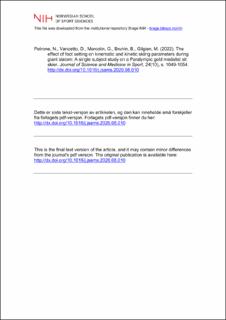| dc.contributor.author | Petrone, Nicola | |
| dc.contributor.author | Vanzetto, Dario | |
| dc.contributor.author | Marcolin, Giuseppe | |
| dc.contributor.author | Bruhin, Björn | |
| dc.contributor.author | Gilgien, Matthias | |
| dc.date.accessioned | 2022-09-14T10:14:21Z | |
| dc.date.available | 2022-09-14T10:14:21Z | |
| dc.date.created | 2020-11-01T10:45:20Z | |
| dc.date.issued | 2020 | |
| dc.identifier.citation | Journal of Science and Medicine in Sport. 2020, 24(10), 1049-1054. | en_US |
| dc.identifier.issn | 1440-2440 | |
| dc.identifier.uri | https://hdl.handle.net/11250/3017764 | |
| dc.description | I Brage finner du siste tekst-versjon av artikkelen, og den kan inneholde ubetydelige forskjeller fra forlagets pdf-versjon. Forlagets pdf-versjon finner du på sciencedirect.com / In Brage you'll find the final text version of the article, and it may contain insignificant differences from the journal's pdf version. The definitive version is available at sciencedirect.com. | en_US |
| dc.description.abstract | Objectives: Aim was to study the effect of monoski foot adjustment on kinematic and kinetic skiing parameters expressing sit skier’s technique. Design: Independent variable was skier position with respect to bindings, acting on position of monoski foot sole clamp. Front (F), Mid (M) and Rear (R) settings changed with intervals of 20 mm. Course time, skiing speed, Ground Reaction Forces (GRFs) magnitude and point of application and damper stroke were dependent variables. Method: A Paralympic monoski was equipped with a dynamometric binding plate measuring GRFs, roll and pitch moments. A Paralympic gold medalist (LW10-1) was involved. Skier trajectory and gates location were measured by a differential global navigation satellite system (GNSS) in steep and medium steep slope portions. The athlete performed two giant slalom runs for each foot setting the same day. Results: GRFs, center of pressure (COP) and variations with foot settings were measured. Peaks values up to 3.36 times the total weight and damper speed of 675 mm/s in compression were found. Fastest runs, highest peak loads and best subjective ratings were recorded with F setting. COP mean values were influenced by foot adjustments. GRFs in left turns were 54% larger than in the right turns with F setting on steep slope. Conclusions: The monoski foot adjustment influenced kinematic and kinetic skiing, with F setting showing best results. A skier asymmetric behavior between right and left turning was discovered. Findings can support the design of monoskis for a wider dissemination of Paralympic alpine sit skiing. | en_US |
| dc.language.iso | eng | en_US |
| dc.subject | paralympic alpine sit skiing | en_US |
| dc.subject | giant slalom | en_US |
| dc.subject | monoski adjustment | en_US |
| dc.subject | kinematics | en_US |
| dc.subject | ground reaction forces | en_US |
| dc.subject | GNSS | en_US |
| dc.title | The effect of foot setting on kinematic and kinetic skiing parameters during giant slalom: A single subject study on a Paralympic gold medalist sit skier | en_US |
| dc.title.alternative | The effect of foot setting on kinematic and kinetic skiing parameters during giant slalom: A single subject study on a Paralympic gold medalist sit skier | en_US |
| dc.type | Peer reviewed | en_US |
| dc.type | Journal article | en_US |
| dc.description.version | acceptedVersion | en_US |
| dc.source.pagenumber | 6 | en_US |
| dc.source.journal | Journal of Science and Medicine in Sport | en_US |
| dc.identifier.doi | 10.1016/j.jsams.2020.08.010 | |
| dc.identifier.cristin | 1843854 | |
| dc.description.localcode | Institutt for fysisk prestasjonsevne / Department of Physical Performance | en_US |
| cristin.ispublished | true | |
| cristin.fulltext | postprint | |
| cristin.qualitycode | 1 | |
